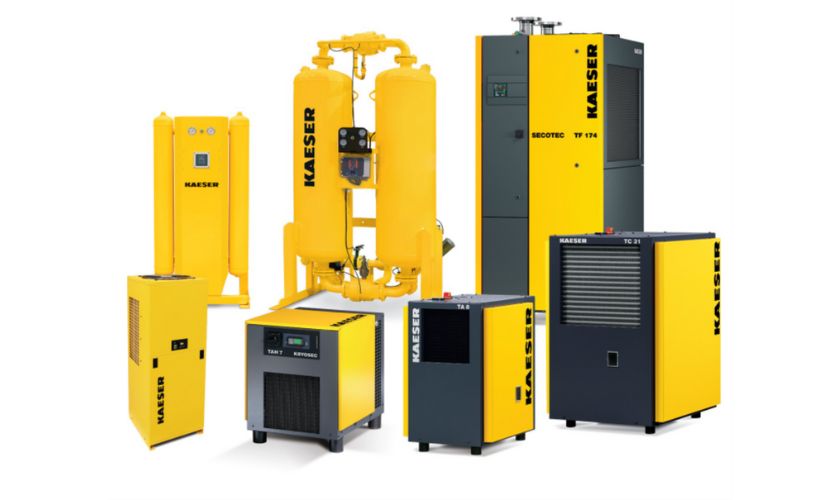
The benefits and recognition as to the importance of compressed air quality are more prevalent than ever, as the pursuit of production quality and energy efficiency becomes more and more apparent.
The efficient management of compressed air is crucial for applications across all manner of industries, from Automotive to Ziplock bags, energy efficiency to compressed air quality, many lenses are now pointed at compressed air systems.
Why?
The realization of compressed air not being free and becoming arguably the 4th most expensive utility to own and operate, means that users are doing a better job at monitoring, measuring, and maintaining what they do pneumatically. Whether you and your facility manufacture food, packaging, automotive, pharmaceutical, beverage, dairy, aerospace, chemical, textiles, or any other products, compressed air is most likely being used, and is expensive to generate and maintain. Some might say that “it’s a necessary evil.”
One of the most common challenges in compressed air systems is moisture contamination. This blog is intended to guide you through the whys and wherefores regarding compressed air purification questions, selection, sizing and equipment styles and types.
Let’s begin with Pressure dewpoint, often called PDP, and a universally recognized way to measure the residual water content in a compressed air system.
What is PDP?
This was explained to me beautifully by one of my mentors Mike Doel. The ambient air that we are surrounded by right now holds invisible water vapor. In order to condense this vapor into liquid, the air must be cooled to a temperature where it can no longer hold all of the water, because the “dewpoint” has been reached. Subsequently the water vapor condenses into liquid.
Mike's analogy was this: “Imagine going outside on a hot summer day with a cold glass of water. Of course, the glass is wet inside because of the water, but the outside glass surface will be dry. If we transport our cold glass of water outside, the temperature of the cold water exchanges with the hot ambient air. When the ambient temperature reaches its dewpoint, the vapor surrounding the outside of the glass condenses into liquid, and the glass becomes wet on its’ outside surface too.” In fact, compressed air purification fundamentals are further explained with this analogy, when the water on the outside of the glass begins to trickle down from the top of the glass to the bottom, via gravity. This is the practice of “coalescing”, epitomized. The small beads of liquid water gravitate from the top of the glass towards the bottom, capturing other beads as they descend, to become bigger and heavier droplets. Eventually they reach the surface that your glass is sitting on and form a puddle.
Did you ever wonder how coalescing filters work? Hopefully, this simple explanation helped kill two birds with one stone, explaining both pressure dewpoint and coalescing methodology.
Coalescing filters are highly effective at removing liquid water and oil from compressed air systems, and we will explore this in greater detail later.
Which style or type of compressed air dryer do I need?
Now that we have a better understanding of what a pressure dewpoint is, we need to establish what your requirements might be in the facility you work in. Air dryer styles are based on their ability to achieve a certain pressure dewpoint, (PDP).
Important Note: the following air dryer guide is based on the operating conditions listed below being present.
✓ Inlet pressure = 100psig
✓ Ambient temperature = 100°F
✓ Compressed air inlet temperature = 100°F
If these conditions are the ones that you install the following air dryers into, you can expect the following pressure dewpoints to be delivered.
We will convert these dewpoints into simple air quality terms later.
Refrigerated air dryers can achieve +37°F (3°C) PDP
This means that as long as the dryer is performing properly, the compressed air piping can be exposed to ambient conditions of 37.5°F or higher and the residual water in the air will remain as a vapor and not condense into liquid. Most standard manufacturing facilities function effectively with fridge dryer compressed air quality.
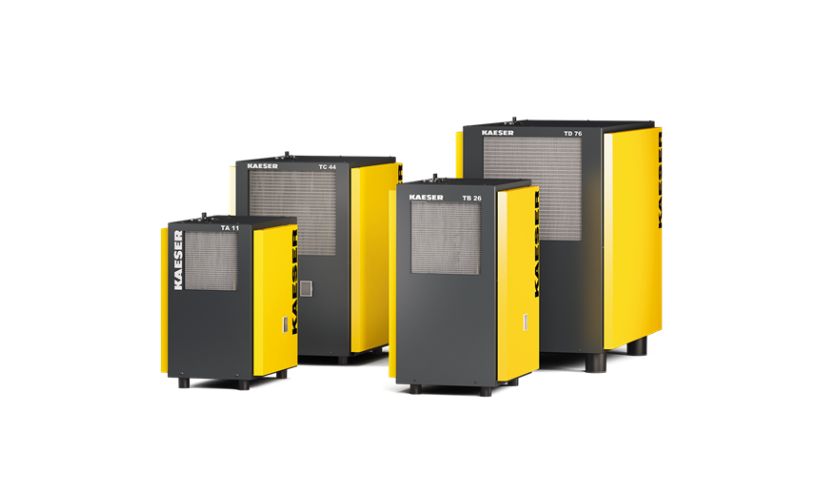
Desiccant air dryers can achieve -40°F (-40°C) PDP
This assumes the same operating and ambient conditions, outlined above, of 100psig, 100°F and 100°F. Desiccant air dryers are an effective means of drying compressed air in applications where the compressed air is exposed to very low ambient temperatures. Cold storage, outdoor uses, frozen food production and warehousing are common uses of desiccant dryers.

You have likely held desiccant in a small sachet if you’ve unpacked electronic equipment or shoes. It has a warning stating “Do not eat.”
Three types of desiccant media are available for the filling of the desiccant bed(s).
Silica Gel will normally achieve a -20°F (-28°C) PDP, if the purge loss is approximately 15%.
Activated Alumina will normally achieve a -40°F (-40°C) PDP, if the purge loss is approximately 15%.

Molecular Sieve will normally achieve a -70°F (-56°C) PDP, if the purge loss is approximately 15%.
Desiccant dryers are available as a single canister model, with a replaceable desiccant bed cartridge. These models require constant monitoring, frequent consumable expense, and maintenance. They cannot tolerate oil contamination either, so we strongly recommend the addition of a liquid oil coalescing pre-filter assembly.
The more commonly found desiccant air dryer style is the twin tower type. This version has two identical towers, positioned in parallel, but with a valved arrangement dictating the flow of compressed air through only one tower at a time for a specific period. Air passes over one bed of desiccant and out to the plant. Some of the exiting dried air is directed, in the opposite direction, into the second “twin” tower, which has been depressurized, and is venting to atmosphere.
Once the tower/bed online is deemed to be saturated with the moisture its desiccant has absorbed, it must be regenerated, or dried.
The valves are sent signals to move position and redirect the compressed air through the now regenerated/dried tower. As before, some of the dried compressed air, exiting the dryer, is redirected into the depressurized wet tower and vented to atmosphere. This process is called desiccant regeneration, and this occurs continually when the drying towers require regeneration.
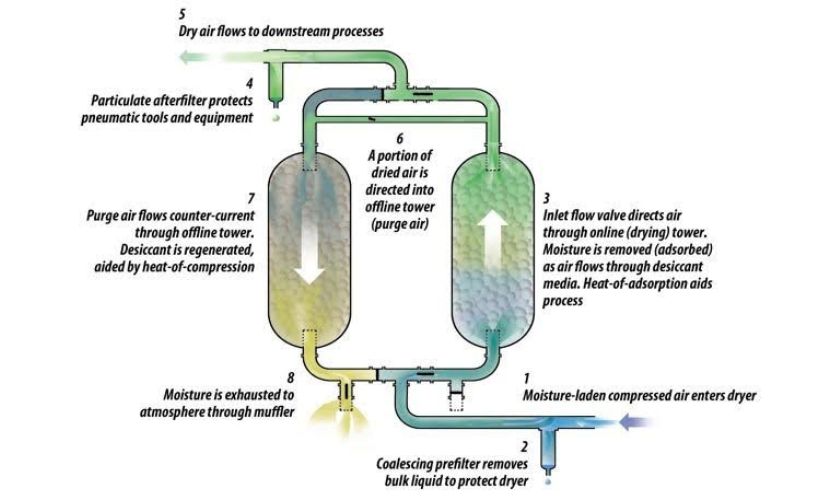
Is there a desiccant dryer option with less than 15% purge loss rate?
Heatless desiccant air dryers are usually the least expensive style of twin tower dryers; however, they consume approximately 15% compressed air purge loss in order to regenerate the wet desiccant bed, and this can occur as often as every 4 minutes of a 5-minute period. To put context to this a 1,000cfm heatless twin tower desiccant dryer consumes 150cfm @ 100psig every 4 minutes of a 5-minute cycle. In some facilities, compressor capacity cannot cope with this increased demand and the electrical costs associated with producing a 15% purge loss to be blown from a muffler to the atmosphere, more often than not, can be incredibly expensive. This expense is amplified in hydro consumption, carbon footprint, maintenance cost, and hydro expense. With this in mind, it is advisable to consider and investigate all of the available options for desiccant air dryer regeneration, especially when the flow rate exceeds 500cfm. Other twin tower options include some of the following alternatives.
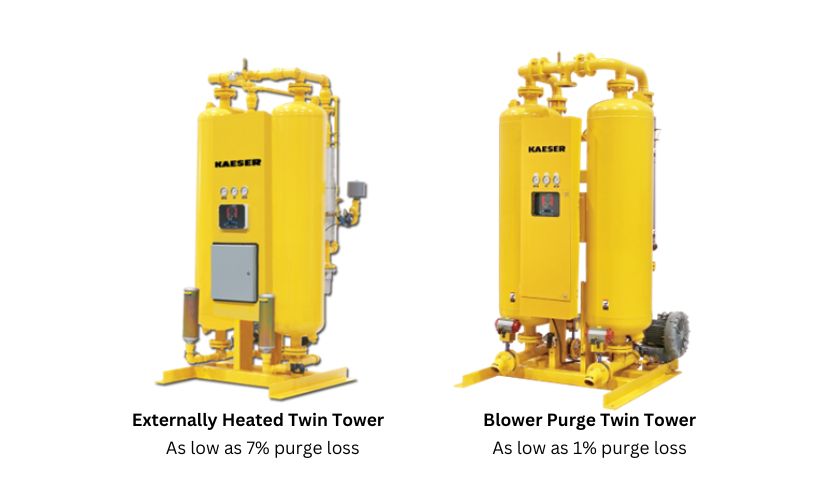
How do I establish the compressed air quality that my facility, applications, and processes require?
The ISO network of national standards created an easy-to-follow compressed air quality class guide, shown below, for solid particles and dirt, residual oil content, and liquid water levels.
The following Link is a simplistic visual map of the equipment required to meet, or exceed, ISO quality class 0 through X.
Currently, there are 3 standards in use, and these relate to compressed air quality, testing, and purity. The most commonly found standard in Ontario, Canada is ISO8573-1:2010. In addition to quality classes, there is a means of testing and analyzing compressed air quality, (CSA standard Z-180) and we will elaborate on this later. (See the breathing air section of this blog.)
The ISO standard is divided into three main groups of contaminants: Solid particulates, water, both liquid and vapor, oil, both aerosols and vapor. Each of these categories has up to ten different purity classes, eight for particulates, ten for water and five for oil.
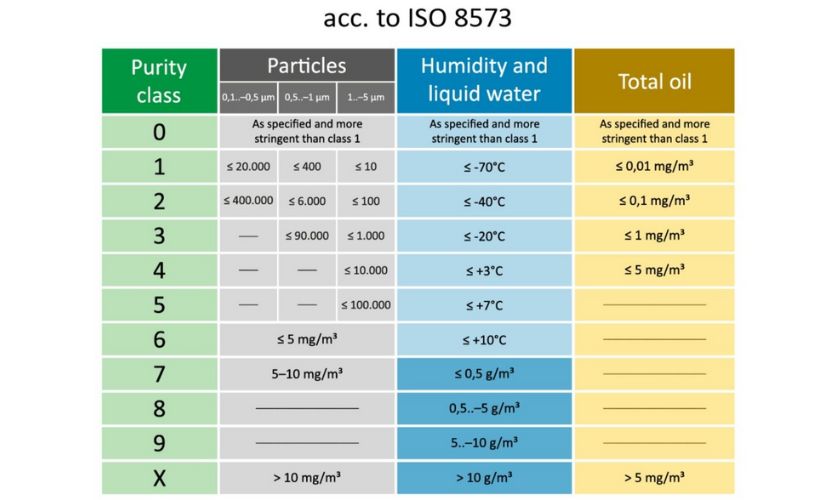
Is there a compressed air dryer that doesn’t require power, or is it intrinsically safe?
Membrane dryers are an ideal solution when electrical power is unavailable or prohibited. These dryers are designed for low CFM flows making them ideal for point of use applications, or tight spaces.
Compact and robust, membrane dryers function by passing compressed air through hollow fibre permeable membranes that selectively remove water vapor molecules, suppressing the dewpoint of compressed air in the minus temperature range. Capable of delivering PDP’s from +10°C to −40°C, dewpoint suppression is relative to the inlet air temperature.
Energy efficiency is ensured by virtue of purge air nozzles, in Kaeser’s KMM dryer range, which features a defined diameter aperture. During production downtimes, an optional “purge air stop valve”, further enhances energy savings, and increases the ROI and cost-effectiveness of a membrane dryer.
What advantages will a dryer give me?
Some of the advantages you can expect when you add an air dryer to your compressed air system include:
- Elimination of wet compressed air.
- An end to frozen pipes and valves.
- Increased compressed air quality, resulting in better paint finishes, faster cutting times, product spoilage avoidance, cleaner laser cuts, increased product shelf life, microbial reductions, and air tool service life increases, to name a few.
- Without effective moisture removal - water will corrode pipes, tools, valves, cylinders and machinery. Subsequently maintenance costs are detrimentally impacted.
- Microbial growth reduction, which in the pharmaceutical and food and beverage industries is of paramount importance. Wet air is a perfect breeding ground for bacteria growth, which often leads to food and beverage product spoilage, or audit failure.
- General efficiency improvements in system uptime, maintenance costs, health and safety and so on.
Who makes breathable compressed air dryers?
The Kaeser Breathing Air System (KBS) is a complete purification system. Kaeser’s KBS Breathing Air System is a complete “plug and play” purification system. Engineered and designed to ensure end users receive breathable compressed air quality which meets all local, and international standards such as CSA Z-180, OSHA, ISO12021 and DIN3188.
The KBS effectively removes contaminants such as CO, moisture, solid particulates, oil, (vapors and odors), and hydrocarbons from the compressed air stream.
Which filters do I need for my dryer?
In short, protect the investment you made in your air dryer purchase.
Fridge dryers include two heat exchangers, air to air and air to refrigerant. Both exchangers have small capillary tubes, and to ensure service life longevity, and protection from “fouling”, the installation of a high efficiency particulate removing filter assembly is advisable.
The air to air exchanger cools the incoming hot compressed air, by virtue of exchange with the cold dischage air. The temperature of this reheated exiting compressed air is the premium and perfect temperature for capturing oil. The air dryer discharge pipe is the ideal, and recommended location for the installation of a high efficiency coalescing filter assembly.
Desiccant dryers are filled with desiccant media/beads, and this media will not and cannot tolerate oil. Let’s say that oil is a desiccant air dryer's nemesis.
To protect the media from oil contamination, at least one, and in a perfect world two, coalescing oil removal filter assemblies should be installed upstream of a desiccant dryer. The additional second filter assembly investment and regular filter element replacement maintenance will pay dividends in the long run, as desiccant is typically replaced every 3 to 5 years. With top-shelf pre-filtration and diligent element replacement, a desiccant service life expectancy of 5 years or more is easily achievable. This practice prolongs the avoidance of dryer loss and downtime caused by premature desiccant replacement and the associated service and disposal costs. Please invest wisely in your pre-filtration, you’ll thank us later.
As previously mentioned, desiccant dryer valves change position on a regular basis and this subjects the desiccant media to a regular pummelling. Subsequently, the media discharges a talcum powder-like substance, and it will play havoc with downstream, tubing, cylinders and valves. Therefore it is essential to install a high efficiency, particulate removal after filter assembly, downstream of all desiccant air dryers.
Please note: desiccant dryers with heaters will require high-temperature particulate removal after filter elements.
When should I replace my desiccant?
A desiccant air dryer's nemesis is oil. Protect your dryer with adequate coalescing oil removal pre-filtration, and the desiccant media will last between 3 to 5 years.
Regular air compressor maintenance, dual-stage oil removing pre-filtration, and high-efficiency OEM filter element use, replaced on a regular basis, will inevitably increase the service life expectancy of your desiccant media.
Do compressed air dryers require a ticketed or specific service skillset?
Air Solutions employs 16 full-time, factory-trained, service technicians. Three of these are qualified and ticketed refrigeration mechanics. Our team can service any type and manufacturers of air dryers, from membrane, high temp or standard refrigerated dryers and all manner of desiccant dryers. Rental dryers are available from stock, and our service is available 24/7.

